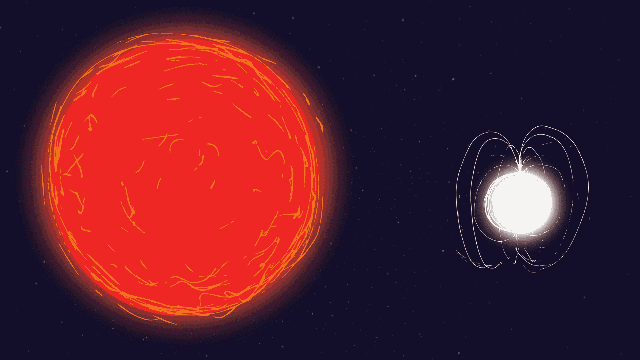Neutron stars aren’t the twinkle-twinkle kind you typically see in the night sky. They’re stellar corpses, and incredibly dense sources of gravity, with perhaps 1.5 times the mass of the Sun packed into an area only a couple of dozen kilometres across. Around 9000 light years away from Earth, one neutron stars seems to have befriended a red dwarf. And scientists observed the new relationship beginning in a flash of energy.
Artist’s impression of what’s going on here. Graphic: ESA
An international team of researchers first spotted what looked like the symbiotic relationship of an old red dwarf star waking up neutron star on 13 August 2017, using an Earth-orbiting telescope called INTEGRAL. While binary stars are common, a lot of things about this finding, from capturing the initial blast that signalled the start of the stellar relationship, were a surprise.
“It was a very exciting find,” study author Arash Bahramian from Michigan State University told Gizmodo, “Especially given that it’s rare to see the start of the process.”
How does a friendly relationship like this begin? Essentially, the binary consists of a dying old red giant star that has expelled its outer layer as stellar wind. The neutron star sucked up that matter and began to send off a sustained potent X-ray emission. The researchers’ results will be published in Astronomy and Astrophysics.
One researcher not involved in the paper, Liz Bartlett from the European Southern Observatory, agreed that the observations were pretty cool. As she explained in an email, “this source has, for some reason, got brighter and, the next interesting point, *stayed brighter* – its ‘normal’ behaviour seems to have changed.”
She also pointed out that events such as these are really easy to miss, but “the source was detected in a region of sky that INTEGRAL has been monitoring for 15 years, so we can say with a reasonable level of certainty that this [system] isn’t one of these things that regularly has these outbursts every few weeks/months/days/few years”.
Of course, Bahramian pointed out, the system could have had an outburst before INTEGRAL started looking, so they might not be observing the very beginning of the binary relationship. Even so, it’s at least close to the start of this behaviour, he said.
Bartlett noted that the paper calls the neutron star “persistent”, but it’s only been going for less than a year. “It’s certainly would be unusual for this to be just one really really long outburst… but it could be. Claiming that this is a new, persistent X-ray source could be a little premature. But it’s the conclusion that I would come to too, based on this data.”
The sky is an ever-changing place, where winds from a dying star can charge up a nearby corpse. But it’s still quite a sight for us humans.
“There are only maybe a handful of systems that we know on where a neutron star accretes matter from winds of a cold red giant,” he said. “These systems are extremely rare.”
[AandA]
